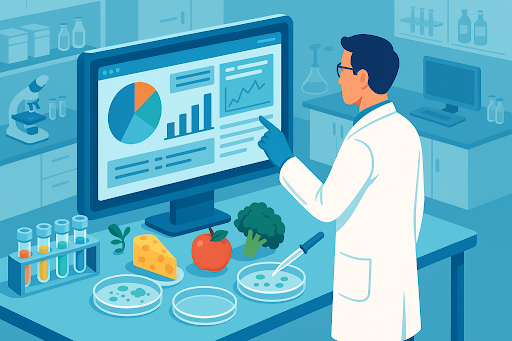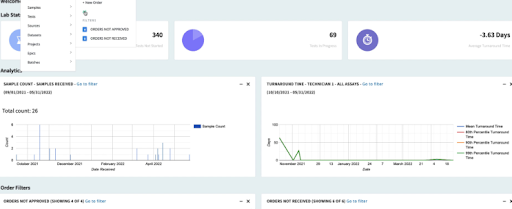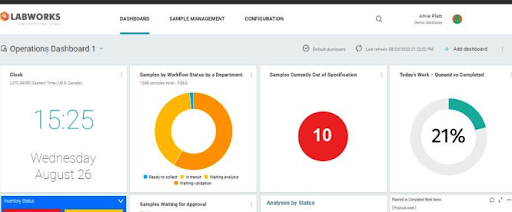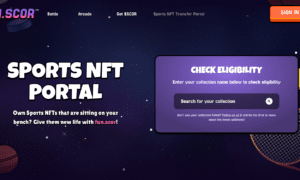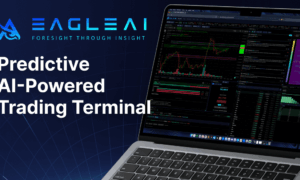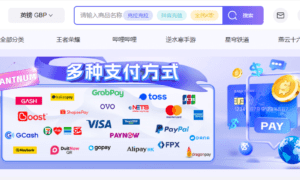The LIMS software market is growing faster than ever. Current valuations show $2.4 billion, and experts project it to reach $3.8 billion by 2029. Food and beverage testing laboratories depend on these sophisticated systems to ensure product safety, quality, and regulatory compliance.
Labs of all sizes are streamlining processes by implementing Laboratory Information Management Systems (LIMS) in 2024. The numbers show that 61% of labs point to elimination of manual processes as their main benefit. Food LIMS solutions help testing facilities track samples better, automate data recording, and stay compliant with FDA, FSMA, and ISO 17025 standards. Food testing labs that use top LIMS systems have cut compliance errors by up to 40%. This makes FDA inspections and recalls much easier to document.
Lab management needs have become more complex, making the right software choice crucial. Let’s take a closer look at four leading LIMS vendors for food testing laboratories. We’ll compare 1LIMS, QBench, LabWare LIMS, and Labworks based on their deployment models, implementation timelines, regulatory compliance features, and industry-specific capabilities. This comparison will help you make an informed decision for your 2025 technology roadmap.
1LIMS

1LIMS is one of the best LIMS software solutions for food and beverage labs that want to simplify their quality control. This cloud-based lab information system helps manage quality faster without spending months on setup.
1LIMS key features for food testing labs
Designed to handle samples, results, reports and testing methodes, 1LIMS centralizes all lab data in one intuitive, modular platform, allowing teams to manage, prioritize, and track test orders in real time. Thanks to automated workflows, lab work that once took hours now takes minutes. 1LIMS cuts delays by auto-triggering retests when results seem off and supports full traceability through automated sample labeling.
Compliance is built in, with audit trails, electronic signatures, and role-based access. 1LIMS supports ISO, FDA, GDPR, and more, making regulatory reporting easy. The team can generate and print QR or barcode labels directly in the system, with each label linked to the sample’s full testing history available with a single scan. The system can be integrated with lots of service labs such as Eurofins, SGS, and Tentamus case you outsource some of your analysis to a third-party.
1LIMS also offers no-commitment LabCheck, an onboarding program with expert guidance based on Lean Six Sigma principles. The program starts with a deep lab assessment to find process gaps and improvement areas. This ensures a smooth rollout aligned with KPIs and quick productivity gains. For example, LabCheck allowed Frifag Märwil, a producer of high-quality poultry meat, to discover how lab digitalization could save them up to CHF 15,400 annually.
Once live, you get a fully customizable, compliant system ready to scale.
1LIMS pros and cons
Pros:
- Faster setup compared to other LIMS systems (30 days vs 6+ months)
- Neutral and in-depth assessment tailored to your lab’s specific workflows and resources (LabCheck workshop)
- Boosts sample throughput by 30% in most cases
- Reduces manual data work by 70% on average
- Shows every step with detailed audit trails
- Easy sample access through QR/barcode scanning
- Intuitive dashboard design
Cons:
- The system may need tweaking due to industry-specific lab workflows
- Cloud-based model may not suit all labs
1LIMS pricing and deployment
1LIMS subscription cost typically ranges from $70 to $125 (€45 – €95) per user per month. The final price is based on the module configuration used and the number of analyses or orders the laboratory performs annually. Extra modules cost about $70 per user monthly, which can add up as labs need more features.
1LIMS requires less IT setup upfront, which appeals to labs looking to save on tech costs. Labs can start using it in just one month, much faster than traditional LIMS setups that often take six months or more.
Implementation follows clear steps: assessing lab needs, identifying process gaps, configuring the system, migrating data, setting up integrations, running tests, training staff, and providing ongoing support.
1LIMS best use cases in food & beverage
1LIMS has been used by recognized companies across the food industry in Switzerland, such as Zweifel Chips & Snacks AG and Micarna Group.
At Micarna Group, paper-based processes made compliance audits stressful and limited sample throughput. By implementing 1LIMS, Micarna doubled its sample processing capacity, cut administrative workload by 50%, and significantly reduced per-sample analysis costs – all while making audits stress-free through full traceability.
Similarly, Zweifel Chips & Snacks AG eliminated the problem of lost samples and improved overall lab efficiency by replacing Excel and paper records with a centralized digital platform. The result was faster workflows, enhanced traceability, and simplified compliance for food safety certifications.
In both cases, 1LIMS delivered measurable productivity gains, reduced risk of error, and improved audit readiness.
QBench

QBench provides a modern cloud-based Laboratory Information Management System (LIMS) that gives food testing labs the ability to automate workflows and improve operational efficiency. The system ranks among the top LIMS platforms with many industry awards. G2 named it the highest-rated LIMS in North America.
QBench key features for food testing labs
QBench has specialized features to help food and beverage testing operations improve quality control. The platform tracks production lot numbers, product lines, and product specifications across customer portfolios. Food safety professionals value QBench’s support for different testing types. These include microbiological analyzes, composition analysis, allergen testing, pesticide residue detection, and shelf-life determination.
The platform’s no-code configuration tools let food labs customize fields, workflows, and reporting without needing technical expertise. Labs can adapt the system as their processes change, which is vital given the evolving nature of food safety regulations.
Sample tracking is one of QBench’s strengths. The system prevents mix-ups that can get pricey through proper sample accessioning and barcode generation. The system streamlines compliance by tracking internal and external samples, assigns required analyzes, manages testing progress, and delivers results through its customer portal.
QBench pros and cons
Pros:
- System adapts to lab-specific workflows and naming conventions
- Implementation takes weeks instead of 6-12 months like competitors
- Powerful REST API merges with other laboratory systems
- ISO 17025 compatibility helps food labs get accreditation
- No-code automation engine removes manual steps and speeds up sample processing
- Integrated Quality Management System tracks issues, root causes, and corrective actions
Cons:
- Higher-priced tiers limit QMS features, creating barriers for smaller labs with compliance needs
- Some users report performance issues when loading filters, searches, or generating reports
- Users mention a steep learning curve with workflows that aren’t user-friendly at first
- Some users describe the self-learning documentation as “sparse”
QBench pricing and plans
QBench offers tiered subscription plans with per-user monthly rates. The Foundation plan costs $275 per user monthly (billed annually at $3,300) and helps streamline basic lab operations. The Growth tier costs $325 per user monthly ($3,900 annually) and adds customer portals, instrument integrations, and API access.
Labs needing quality management features can choose the Advanced plan at $425 per user monthly ($5,100 annually). All plans need at least five users, with discounts starting at ten users. Larger organizations can get custom Enterprise packages with volume-based pricing and extra features like SSO, MFA, and divisions.
Labs should budget for additional professional services costs since implementation services aren’t part of subscription costs.
QBench best use cases in food & beverage
Light Labs shows how well QBench works in the food sector. This modern testing lab used QBench to learn about food products’ purity and nutritional integrity. They valued QBench’s flexible configuration and RESTful API because it supported their custom integrations and automations. They went from kickoff to processing samples in about 40 days.
QBench works best in laboratories that do microbiological analyzes, analytical chemistry, and PCR testing for food safety. Both internal quality control labs and third-party testing facilities use the system effectively. It handles various sample types like packaged food, supplements, beverages, produce, and feed.
The system is ideal for food labs seeking ISO 17025 accreditation since it meets requirements in the ISO 17025:2017 standard, which includes specific LIMS requirements. Its instrument integration capabilities work with analytical instrumentation to sync hundreds of data points and liquid handling equipment for plate map tracking.
LabWare LIMS

LabWare LIMS is a 30-year-old player in the laboratory information management system space. The platform serves food and beverage companies with its complete solution. Unlike newer cloud-only solutions, LabWare gives you both traditional on-premises deployment and SaaS options. This makes it a good fit for organizations with different IT infrastructure priorities.
LabWare LIMS key features for food testing labs
LabWare LIMS gives food testing laboratories extensive functionality. Note that the system lets you trace everything from raw materials to finished products. Food manufacturers can keep detailed records throughout production. The platform shines at microbiological testing. It comes with a specialized Micro Module that has pre-configured workflows to automate sample scheduling, preparation, testing, and instrument integration.
The platform supports lab automation and paperless operations through built-in tools that make connecting with analyzers and robotics platforms simple. You’ll find a configurable rules engine that boosts efficiency by automating routine tasks like sample registration and result entry. Food safety professionals love LabWare’s Lot Manager because it defines testing protocols for raw materials, intermediates, and finished products.
The system also has specialized tools for:
- Shelf life testing with stability chamber condition management
- Method execution with advanced data review capabilities
- Electronic laboratory notebook (ELN) functionality to manage large data sets
- Mobile access through LabWare MOBILE on Android and iOS devices
LabWare LIMS pros and cons
Pros:
- Instrument integration removes manual labor by automating routine tasks
- Strong security features with Active Directory integration, end-to-end encryption, and role-based permissions
- 99.5% availability guarantee will give a reliable system access
- Support team ready 24/7 to help with troubleshooting
- Pre-configured workflows that follow industry best practices cut implementation time
- Meets FDA, MHRA, and 21 CFR Part 11 regulatory requirements
Cons:
- Implementation can take months longer than newer cloud-native solutions
- Costs run high with substantial customization and professional services expenses
- System maintenance needs specialized expertise
- Users face a steep learning curve that requires complete training programs
- Projects typically cost $15,000 for simple data organization to $60,000+ for complete digital transformation
LabWare LIMS pricing overview
LabWare uses multiple pricing models. SaaS subscriptions start at $300 monthly for simple functionality, but actual costs vary by a lot based on specific needs. The perpetual licensing model needs larger upfront payments. Government pricing shows $7,043.22 per user plus a 14% annual maintenance fee. Private sector rates usually run higher.
The base subscription is just the start of your total investment. Implementation services often cost as much as or more than the software license. Many organizations find they need dedicated LIMS administrators or ongoing professional services to maintain their systems.
LabWare LIMS best use cases in food & beverage
LabWare has built a strong presence in the food and beverage sector. Their client list includes Bakkavor, Campbell Soup, Cargill, General Mills, Heinz, Hershey’s, Kellogg’s, Kraft, Nestlé, PepsiCo, and SABMiller. The system works best in quality assurance and control environments where complex regulatory compliance matters most.
LabWare proves valuable for food testing labs that need:
- HACCP monitoring and compliance documentation automation
- ERP system integration (including certified SAP integration)
- Complex microbiological testing with automated sample scheduling
- Quality assurance for production with full traceability
LabWare’s industry-specific configurations help food manufacturers stay compliant with strict regulations. The system follows GLP, GALP, cGMP, ISO 9001:2000, FDA, and MHRA data integrity guidelines. Its platform integration capabilities and secure electronic data delivery make it ideal for larger food manufacturers with complex testing needs.
Labworks

Labworks has provided a complete LIMS solution since 1985. The platform helps food testing laboratories automate their sample management workflows. We designed it for food and beverage manufacturers to track and control production processes while saving time and money.
Labworks key features for food testing labs
Labworks LIMS tackles the unique challenges food testing laboratories face daily. The system handles the whole sample lifecycle from creation and scheduling to collection and preparation. The platform maintains full traceability and data integrity throughout testing – a vital part of food safety and regulatory compliance.
Food manufacturers get these specialized features:
- Complete sample tracking with barcoding capabilities
- Automated QA/QC batch management with violation alerts
- Built-in processes for generating certifications and licenses
- Management of payments and interfaces to external systems like USDA
The platform’s Workflow Architect lets users design workflows that match their existing processes. Food testing labs can adapt the system to their specific methods without extensive customization.
Labworks pros and cons
Pros:
- Replaces outdated paper systems and improves security, accountability, and data tracking
- Balances user-friendliness with robust functionality
- Includes integrated inventory management with live tracking
- Works with iOS, Android, and Windows mobile devices
- Uses template-based sample login to simplify data entry
- Connects with over 200 instruments for direct data transfer
Cons:
- Needs dedicated admin resources to perform optimally
- Setup complexity depends on lab requirements
- Takes time for new users to learn
- Might need ongoing support and maintenance
Labworks pricing and licensing
Labs can choose between subscription-based and perpetual licensing models. These options typically cost the same after four years of use.
The price varies based on features like sample lifecycle management, validation tools, specification management, and instrument integration. Lab personnel can manage the system without IT specialists, which reduces technical support costs.
Labs worried about setup costs should note that Labworks LIMS includes modules for automated compliance to speed up deployment.
Labworks best use cases in food & beverage
Food testing environments of all types benefit from Labworks, from internal quality control to contract testing services. The system works best for:
Wine producers who test pesticides and quality control. These companies check bottle strength and detect chemicals that might leach into beverages to ensure product quality and safety.
Food manufacturers who need FDA compliance documentation. The system helps manage and register critical data while meeting regulatory guidelines.
Labs seeking ISO/IEC 17025 accreditation. Food testing labs can overcome technical certification barriers without supplier audits by using Labworks.
Labworks ended up giving food and beverage manufacturers the tools they need to control products and processes. The system provides live data access—vital in food production—while adapting to specific operational needs.
Comparison Table
LIMS Software Comparison for Food Testing Labs
| Feature | 1LIMS | QBench | LabWare LIMS | Labworks |
| Deployment Model | Cloud-based | Cloud-based | On-premises & SaaS | Not mentioned |
| Implementation Time | ~30 days | 3 months | Several months | Not specified |
| F&B Industry Features | • Microbiological testing • Chemical analysis • Sensory evaluation • CoA generation • Sample tracking |
• Microbiological analysis • Composition analysis • Allergen testing • Pesticide residue detection |
• Micro Module • Lot Manager • Shelf life testing • Method execution |
• Sample lifecycle management • QA/QC batch management • Certification generation |
| Configurability | Simple configuration with developer support | No-code configuration tools | Advanced customization options | Workflow Architect tool |
| Integrations | Not specified | REST API with deep integration capabilities | Native instrument integration, SAP certified | 200+ instrument integrations |
| Compliance & Traceability | • FDA • FSMA • ISO standards • Full audit trails |
• ISO 17025 • Quality Management System |
• FDA • MHRA • 21 CFR Part 11 • GLP/GALP/cGMP |
• FDA compliance • ISO/IEC 17025 |
| Top Strengths | • 50% reduction in human errors • 30% increase in sample throughput • 70% reduction in data management effort • Quick implementation |
• Highly adaptable • Modern interface • Strong API capabilities • ISO 17025 compatibility |
• Detailed functionality • Resilient security • 24/7 support • Industry standard compliance |
• Years of expertise • Adaptable solution • Strong inventory management • Mobile compatibility |
| Pricing Model | $45-95/user/month + module costs | Starting $275/user/month | From $300/month (SaaS) or $7,043/user (perpetual) |
Both subscription and perpetual options |
Conclusion
The right LIMS software is a vital decision for food testing laboratories that want to improve efficiency, meet compliance standards, and deliver quality products. My review reveals notable differences between the leading solutions in the market.
1LIMS stands out with quick deployment – labs can get it running in 30 days while other systems take months to implement. This cloud-based system cuts human errors by 50% and boosts sample throughput by 30%. Food testing labs love 1LIMS’s specialized workflows for microbiological testing, chemical analysis, and sensory evaluation. The system reduces quality data management work by 70%, which lets lab staff focus on actual testing instead of paperwork.
QBench matches the cloud deployment model but sets itself apart with no-code tools that let food labs customize their workflows without technical knowledge. The system takes a few weeks longer to implement than 1LIMS. QBench’s powerful REST API capabilities and ISO 17025 compatibility make it a great choice to get food testing accreditation.
LabWare LIMS needs several months to set up but gives users both on-premises and SaaS options with detailed functionality. Food manufacturers value its specialized Micro Module, Lot Manager, and shelf-life testing features. The system’s resilient infrastructure comes with more complexity and higher costs than cloud-based options.
Labworks gives food testing labs a good mix of flexibility and features through its Workflow Architect tool. Labs can design processes that match their current methods. The system’s QA/QC batch management and certification tools address specific food industry needs.
Food testing labs must meet regulatory standards. Each system takes a different approach to FDA, FSMA, ISO standards, and industry regulations. 1LIMS creates complete audit trails and automated compliance documents. LabWare LIMS offers the most detailed compliance features with FDA, MHRA, and 21 CFR Part 11 support.
Food testing laboratories should assess their needs against each solution’s strengths. Cloud systems like 1LIMS deploy faster with lower upfront costs, while established platforms like LabWare offer more customization options. Small and medium-sized food testing labs often do better with 1LIMS’s mix of features, quick setup, and budget-friendly pricing. Larger operations that need complex multi-site setups might prefer LabWare or LabVantage despite longer setup times.
Safe food depends on precise, efficient lab testing. The right LIMS solution improves operations and helps protect public health while building consumer trust. Modern LIMS solutions help food testing labs evolve from reactive quality control centers into proactive safety assurance operations – a worthwhile investment for any food and beverage company.

